Bathing Cats & Kitten: How to Bathe Your Cat or Kitten & Tips without Getting Scratched – A Step-by-Step Guide
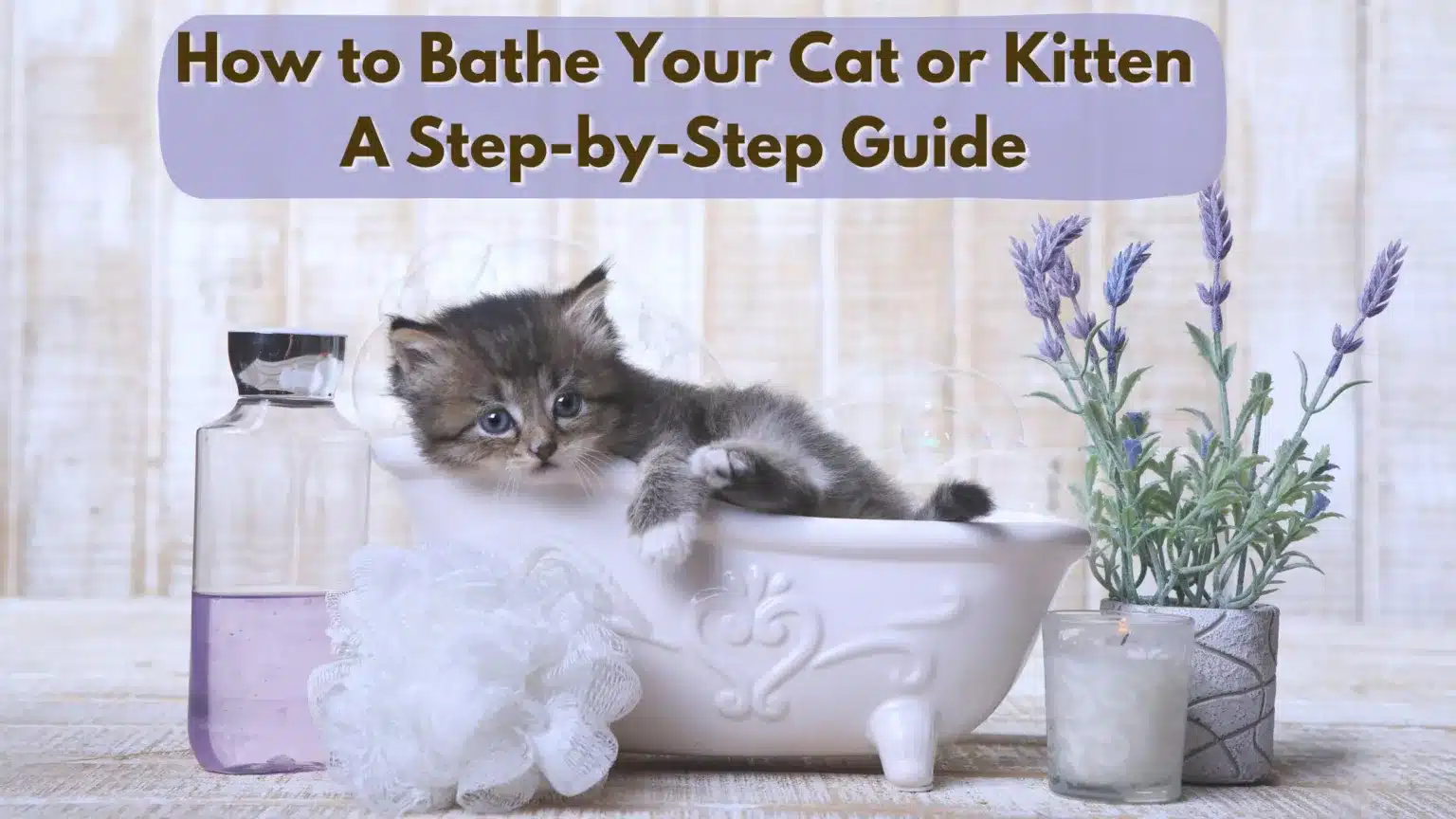
Sharing is Caring!
Introduction
Cats are known for their self-grooming habits, but sometimes they might need a little extra help, especially if they get into something dirty or smelly. Bathing your cat may seem like a daunting task, but with the right approach, it can be a stress-free and even enjoyable experience for both you and your furry friend.
Despite being a routine activity for many pet owners, there are still many questions like “Do cats really need to be bathed?”. Some believe that cats hate water and should never be bathed, while others believe that bathing cats are essential for their hygiene. In this blog article, we will clear up these misconceptions and provide you with step-by-step instructions on how to bathe a cat. By following these tips, you can ensure a safe and successful shower a cat.
Preparing for Cat Bath
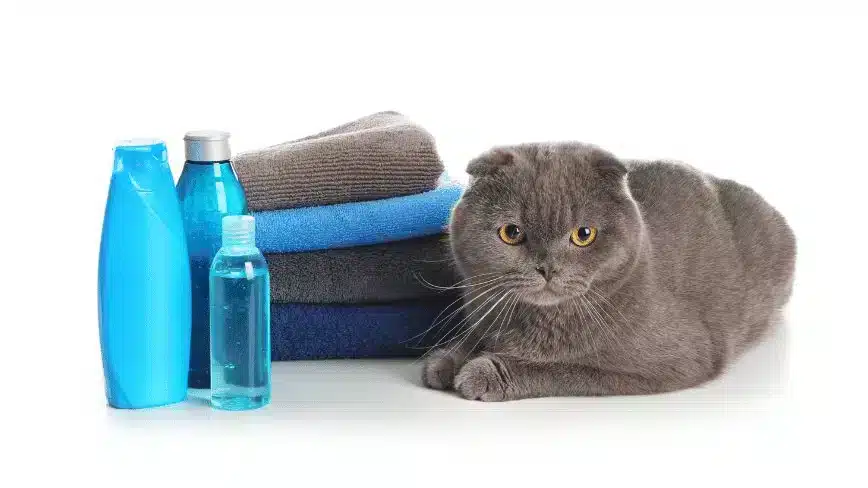
Preparation is crucial when you shower a cat. Before starting the bath, make sure to gather all the essential supplies and select the perfect location. By properly preparing for the shower, you can ensure a safe and successful experience for both you and your furry friend.
A. Gathering supplies
Cat Shampoo
You can buy cat-specific shampoo at any pet store or online retailer. You shouldn’t use human shampoo or you can simply use baby shampoo. Just make sure it’s mild and free of any chemicals that could irritate your cat’s skin.
Cat Conditioner (optional)
Again, this is optional and not necessary if you don’t want to use it. But some people find it helps soften their cat’s fur after a bath, so it may be worth trying if your kitty has dry skin or just tends to be a little more on the scratchy side when you’re giving him or her a bath!
Towels
You’ll need at least one towel in order to dry your cat off after they’ve been bathed! It’s best if you have a second towel around in case you need to wrap up your cat while they’re drying off so they won’t get chilled while they’re still wet from their bath.
Cup for rinsing
A cup can be used to pour water over your cat during the bath, making it easier to rinse away the shampoo and conditioner.
B. Choosing a suitable location for the shower a cat
The location you choose for your cat’s bath should be one that is safe and comfortable for it. The area should be free from any hazards, such as sharp edges or slippery flooring. The tub should also be big enough for your cat to move around freely. You should also make sure that the floor is protected with a non-slip mat or towel so that if your cat does slip, it will not hurt itself.
How to Bathe a Cat: Step-by-Step Guide From a Professional Groomer
Now that you have gathered all the necessary supplies and selected a suitable location, it’s time to start the bath. Here is a step-by-step guide on how to give cat a bath
Step 1: Wetting the cat or kitten

Start with warm water
Get the cat or kitten used to being wet by rubbing a towel over its body, especially on its chest, head, legs, and paws. Then gradually pour water over your cat, avoiding their face and ears. Make sure the water is comfortable for your cat to avoid stress.
Avoid getting water in the ears or face
Use your hand to gently guide the water away from your cat’s face and ears so that they don’t get scared and start scratching at you!
Step 2: Applying cat shampoo
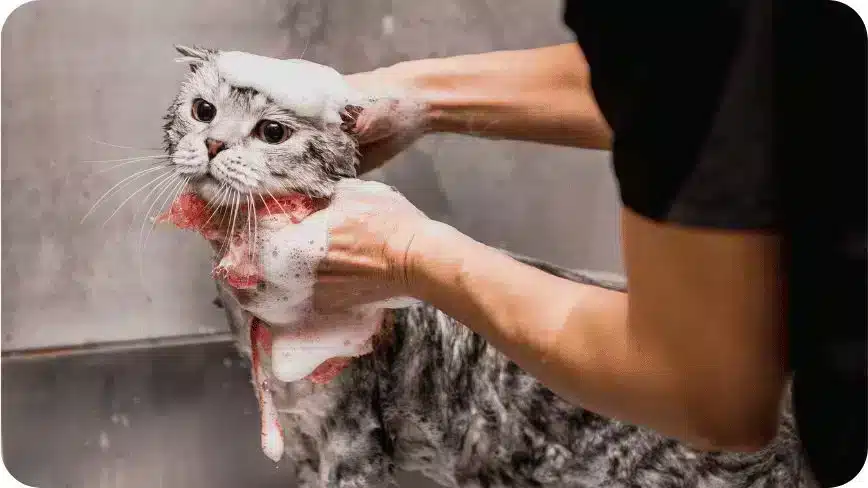
Massage into the fur
Now that you’ve got your cat in the tub, it’s time to apply the shampoo. Apply the shampoo to your cat’s body and massage it in, starting at the head and working your way down to the tail. This is a step that should be done carefully, as cats can get very upset if they feel like they’re being forced into a bath.
Avoid eyes, nose, and mouth
Be careful not to get the shampoo in your cat’s eyes, nose, or mouth. If the shampoo does get in their eyes, rinse them with lukewarm water immediately.
Step 3: Rinsing thoroughly
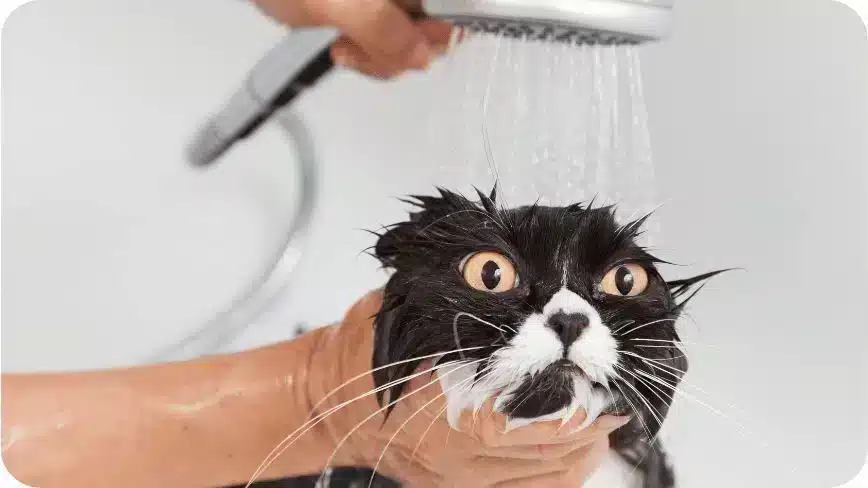
Use warm water
Use lukewarm water with a soft cloth to wash your cat’s fur, being sure to get into all of the nooks and crannies. Be gentle! Cats are very sensitive, so be sure not to rub too hard or scrub too vigorously.
Rinse multiple times
You don’t want to skip this step especially if your furry friend is long haired cats breed A good rinse will remove all of the shampoos from your cat’s fur and prevent them from licking or ingesting it later on.
Step 4: Optional: Conditioning the fur
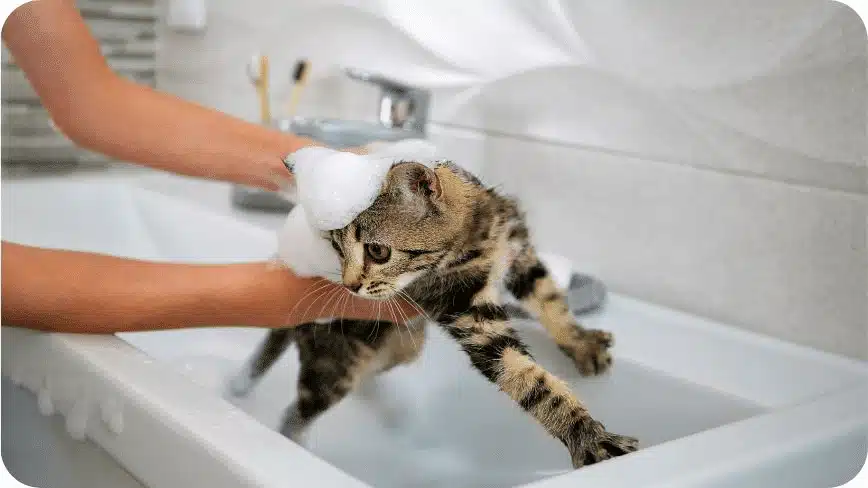
Apply conditioner
If you have chosen to use conditioner, apply conditioner to your cat’s coat, starting at the head and working down to the tail. You can use a spray or squeeze bottle to apply it evenly. Work in small sections and avoid getting any in eyes.
Rinse thoroughly
Rinse the conditioner thoroughly with warm water
Step 5: Drying the cat or kitten
Use a towel
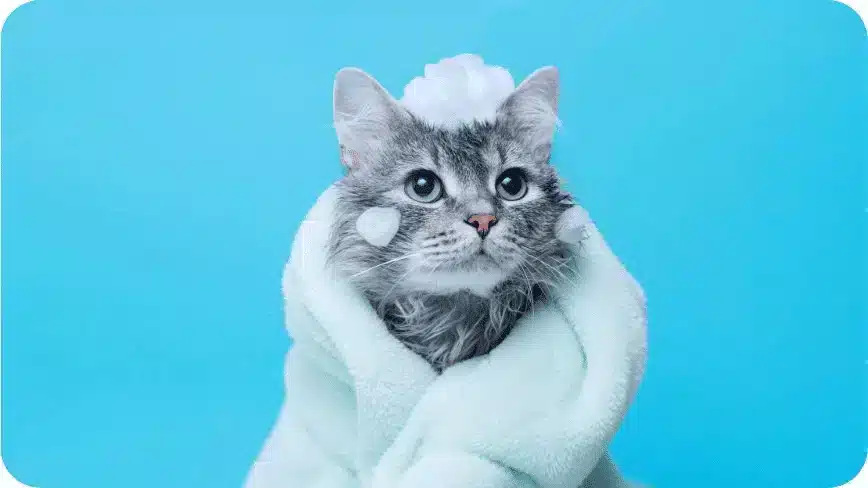
If your furry friend is a long haired or short haired cats breed, both need a towel to keep warm after bathing and to assist with drying.
First, grab a clean and large towel and wrap it around your pet. If they are trying to escape or bite at you during this process, try placing them in a bin or laundry basket so they can’t move around as much while drying off their fur.
Use a hair dryer
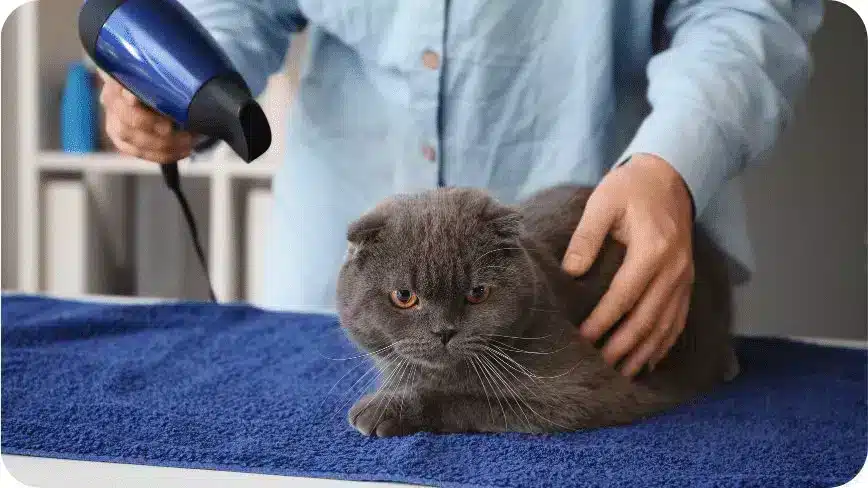
If your cat is a short haired cats breed, using a dry towel should suffice. But if your cat is a long-haired cat, you should use the dryer on low power to aid in drying and so that they are not stressed by the sound of the dryer.
Tips for Reducing Stress and Avoiding Scratches
If you are looking for the answer to question “How can I reduce stress and avoid scratches while bathing my cat?” , stop by this article, it’s for you. Reducing stress and avoiding scratches are important aspects of bathing your cat or kitten. Here are some tips about how to give a cat a bath to help make the experience as smooth and safe as possible:
Trim the cat’s nails
Trimming your cat’s nails before the bath can help reduce the risk of scratches.
If you are confused about how to clip your cat’s nails, please read more: How to Trim Your Cat’s Nails
Introduce the cat or kitten to water gradually
If your cat or kitten is not used to being bathed, gradually introduce them to water over time to help them get comfortable
Make sure the water temperature is comfortable
Use lukewarm water for the bath and check the temperature regularly to make sure it’s not too hot or too cold for your cat. And the temperature recommended by professional groomer is in the range of 100-102°F
Massage for cat
When you shower a cat, use slow and gentle strokes to massage their fur, paying special attention to their neck, back, and legs. This can help to calm them, relieve any tension or discomfort, and improve the overall bonding experience.
Use a gentle touch when bathing
Be gentle and avoid scrubbing or rubbing too hard when washing your cat’s fur. Use a soft cloth and take your time to avoid causing any discomfort or stress.
Reward the cat or kitten after the bath
Reward your cat after the bath with treats or playtime to help them associate the experience with positive outcomes.
Use a hair dryer with low power
To properly dry a wet cat, using a hair dryer on low power is an option. Just be cautious not to aim the dryer directly at your cat’s face or ears, as it could cause discomfort or even harm.
Answers to questions about bathing cats
How often to bathe a cat?For most cats, a bath once every three to four months is sufficient unless they get into something particularly dirty or smelly. However, if your cat has skin conditions or medical issues that require more frequent bathing, it is best to consult with a veterinarian.
How do I prepare my cat for a bath?
The essentials you will need include: a cat shampoo, conditioner (optional), towels, a cup for rinsing, and a location for the bath that is easily accessible and safe for both you and your cat
What is the ideal water temperature for bathing a cat?
The ideal water temperature for bathing a cat is warm, not hot (in the range of 100-102°F). The water should be lukewarm, similar to what you would use for a baby’s bath, so it’s comfortable for the cat.
How do I dry my cat after a bath?
After a bath, you can dry your cat by using a soft, absorbent towel to gently pat its fur dry. You can also use a hair dryer on a low, warm setting, but make sure to keep it at a safe distance and keep it moving so as not to burn the cat’s skin. Avoid using hot air or putting the dryer too close to the cat. It’s best to let the cat air dry for a few minutes first before using a hair dryer.
How can I reduce stress and avoid scratches while bathing my cat? Bathing your kitty can be a stressful experience for you and most cats. To reduce stress and avoid scratches while bathing your cat, it is important to trim their nails, introduce them to water gradually, make sure the water temperature is comfortable, use a gentle touch, reward your cat after the bath, and if using a hair dryer, use low power. Additionally, making the experience as positive as possible for your cat with toys, and using treats or positive reinforcement will also help reduce stress and increase cooperation.
Conclusion
In conclusion, bathing your cat or kitten requires a bit of patience, care, and preparation. By following these guidelines on how to shower a cat, you can make the process less stressful for both you and your furry friend. Besides, Trimming your cat’s nails, gradually introducing them to water, using a gentle touch, rewarding them after the bath, and using a hair dryer with low power can all help reduce stress and avoid scratches.
Finally, remember that each cat is unique and what works for one may not work for another. Keep in mind that most cats do not need frequent baths and that using positive reinforcement and making the experience as positive as possible can help increase cooperation. With these tips, you should be well on your way to giving your cat a stress-free and enjoyable bath time.
Sharing is Caring!
About The Author
PawCool Team
Related Categories: Cats | Cat Health & Care
Latest Articles

Never Miss A Thing!
All pet stories & guides you care about








